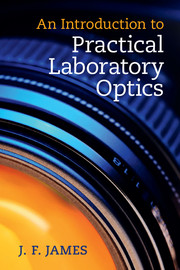Book contents
- Frontmatter
- Contents
- Preface
- 1 Introduction: centred optical systems
- 2 Telescopes and binoculars
- 3 Eyepieces, eyes and colour
- 4 Cameras and camera lenses
- 5 The scientific CCD camera
- 6 Spectrometry
- 7 Interferometers and their uses
- 8 Electro-optical effects and their practical uses
- 9 Microscopes and projectors
- 10 Siderostats and coelostats
- 11 The detection and measurement of radiation
- 12 Practicalities
- Appendix A Gaussian optics
- Appendix B Optical aberrations
- Appendix C A brief introduction to Fourier optics
- Further reading
- Index
Appendix B - Optical aberrations
Published online by Cambridge University Press: 05 October 2014
- Frontmatter
- Contents
- Preface
- 1 Introduction: centred optical systems
- 2 Telescopes and binoculars
- 3 Eyepieces, eyes and colour
- 4 Cameras and camera lenses
- 5 The scientific CCD camera
- 6 Spectrometry
- 7 Interferometers and their uses
- 8 Electro-optical effects and their practical uses
- 9 Microscopes and projectors
- 10 Siderostats and coelostats
- 11 The detection and measurement of radiation
- 12 Practicalities
- Appendix A Gaussian optics
- Appendix B Optical aberrations
- Appendix C A brief introduction to Fourier optics
- Further reading
- Index
Summary
The limits of Gaussian optics
The initial layout of an optical instrument is usually made using simple Gaussian optics, where all apertures and pupils are infinitesimal and all angles are considered small, so that the approximations sin θ = tan θ = θ and cos θ = 1 are adequate.
Geometrical optics, however, is a non-linear discipline and ray-tracing, using the proper values of sines and cosines, quickly reveals that rays do not arrive in the expected places to make sharp images. The quality of an image can be tested by modifying the Gaussian optics to the approximations that sin θ = θ − θ3/6, cos θ = 1 and tan θ = θ + θ3/3 and adjustments can then be made to the positions, curvatures and refractive indices of the various elements of a system to produce better images at the focal surface. Except in rare instances, perfection is not to be expected, and the art of the optical designer is to adjust the values to produce an acceptable result. The problem confronting the designer is that the adjustments all interfere with each other, making the problem miserably complicated.
The problem was first analysed by Ludwig von Seidel of Munich (1821–1896), who codified the five so-called Seidel aberrations of a monochromatic system and derived formulae for computing them.
Information
- Type
- Chapter
- Information
- An Introduction to Practical Laboratory Optics , pp. 162 - 173Publisher: Cambridge University PressPrint publication year: 2014
